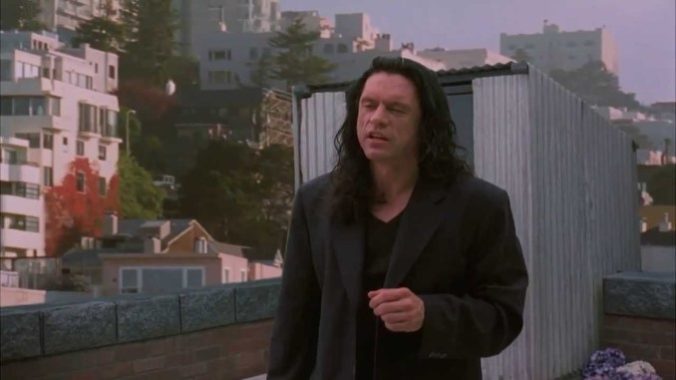The Room of My Own: How Tommy Wiseau’s Legendary Failure Launched My Love of “Bad Movies”

It’s difficult for me to remember precisely how I first became aware of the existence of Tommy Wiseau’s The Room. The year would have been 2007; I can say that with certainty. I would have been a junior at the University of Illinois, an idealistic kid earning an instantly dated degree in print journalism (a terrible idea, which many attempted to disabuse me of to little avail) and cinema studies, and I suspect that my first mention of The Room might have come from one of the film’s early celebrity champions, perhaps as an off-hand reference on a now-forgotten episode of Late Night with Conan O’Brien or The Daily Show. Maybe it was someone like Patton Oswalt, David Cross or Paul Rudd, noted appreciators of cast-off pop cultural trash and ephemera, and early proponents of Wiseau’s magnum opus. Whoever it was, I made a mental note: Track down this odd-sounding vanity project and see The Room for myself.
And in 2007, this was easier said than done, because the cult of The Room (first released 20 years ago this week) was very much still in its infancy. It was several years before Adult Swim would stun the U.S. airwaves by playing the movie as part of their April Fool’s programming. Wiseau was likewise years away from the many winking cameos he would make in alt-comedy properties throughout the 2010s. Most people who had seen The Room at this point were obsessive film nerds who had witnessed it in midnight screenings at genre film festivals, presumably walking out unsure of what they had just witnessed. It certainly wasn’t available via Netflix, even through its dearly departed DVD delivery service. The film was genuinely unknown–I could have walked around town “oh hai’ing” people for an entire afternoon without running into someone who understood the reference.
How lucky I was, then, to find myself in a liberal college town, at the alma mater of Roger Ebert, with ready access to one of the best independent video stores (RIP) I’ve ever had the privilege of visiting. And lo and behold, they owned a copy of The Room. As in, “a copy,” singular. But that was enough, and over the course of the next two years I probably returned to that video store and rented that same copy of The Room another half dozen times, whenever my roommate and I mutually agreed that a sufficient refractory period had passed and we were ready to scramble our brains with another viewing. It had already become ritual to us, long before I’d ever seen the film in a theater full of obnoxiously hooting and hollering film geeks.
The thing that immediately stood out about The Room, besides the utterly alien nature of Tommy Wiseau, was the obvious earnestness of the entire thing. This was so clearly the product of a wounded heart, a bitter cry of resentment toward the universe that one rarely has the courage to put on screen, as its writer-director-star vented his frustrations with the unconquerable cruelty of friendship and the romantic world. We couldn’t help but wonder about the painful reality that must have inspired The Room, even as we watched slack-jawed at its incredibly amateurish performances and inexplicable production choices. Never for a moment did we doubt its sincerity, though, and never for a moment have I believed Wiseau’s subsequent attempts to rebrand the film as “a comedy.” This man never intended anyone to laugh at The Room. He wanted a packed house wiping away tears at Johnny’s tragic demise, hoping beyond hope, perhaps, that the person who broke his heart would see the film and be consumed with guilt over what they did to him.
But we all know that’s not what happened. The legendary shoddiness of The Room–its disappearing characters, immediately introduced and discarded side plots, unintelligible dialogue, and every moment of Wiseau’s performance–instead gave the film an ironic double life, slowly building its status from a cult object of L.A.-area filmmakers and actors, into the foundational text of the modern “bad movie” culture of the web. By the early 2010s, it was gaining widespread infamy. In 2013, Greg Sestero’s The Disaster Artist provided the first behind-the-scenes account of its creation, providing answers for many of the film’s mysteries while introducing just as many new questions. And by 2017, Tommy was being played on screen by James Franco in The Disaster Artist’s Hollywood adaptation, The Room having come full circle from unknown vanity project to the subject of a wide-release Hollywood feature film in the space of 14 years.
-

-

-

-

-

-

-

-

-

-

-

-

-

-

-

-

-

-

-

-

-

-

-

-

-

-

-

-

-

-

-

-

-

-

-

-

-

-

-

-








































